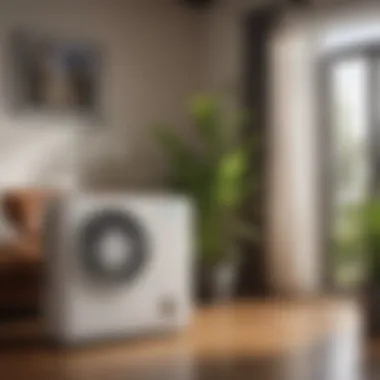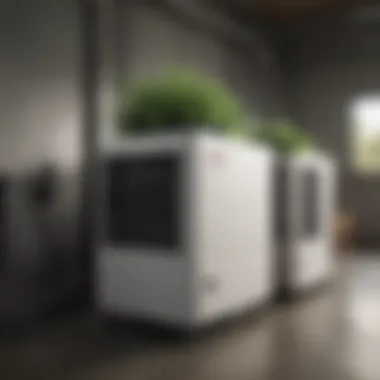Understanding Dehumidifier and Air Conditioner Combos


Intro
In the quest for optimal indoor air quality, many people are looking towards integrated systems that combine the functionalities of dehumidifiers and air conditioners. Understanding how these two appliances work together not only provides insight into their roles but also how they can enhance overall comfort and energy efficiency in a living or working space.
The interaction between dehumidifiers and air conditioners is often overlooked. Individually, each unit has its benefits. An air conditioner lowers the ambient temperature, while a dehumidifier addresses the level of humidity in the air. However, when these two systems are utilized in conjunction, they create a synergy that can lead to more efficient climate control. This article aims to dissect this relationship and provide readers with a comprehensive guide on the combined use of dehumidifiers and air conditioners.
In the following sections, vital aspects of these appliances will be discussed. Topics will cover the mechanisms at play in this interplay, the advantages of using both devices together, and essential considerations for selecting and installing such a combo system.
Preamble to Dehumidifiers and Air Conditioners
Dehumidifiers and air conditioners serve crucial roles in indoor environmental management. Understanding their functionalities helps users make informed decisions for their specific needs, especially in contexts like agriculture where humidity control is vital. The combination of these systems yields numerous benefits across various settings.
Functionality of Dehumidifiers
Dehumidifiers function by removing excess moisture from the air. They operate on a simple principle: drawing in moist air, cooling it to below its dew point, and collecting the resulting condensation. This process helps maintain optimal humidity levels, typically between 30% to 50%. Lower humidity can prevent mold growth, reduce allergens, and improve comfort.
Additionally, dehumidifiers often come equipped with features such as adjustable humidity settings and continuous drainage options. Some modern units even have built-in air filtration, which further promotes better air quality. For agricultural farmers, controlling humidity is essential to protect crops and stored grains. High humidity can lead to fungal infections, spoilage, and reduced quality of products.
Functionality of Air Conditioners
Air conditioners primarily focus on cooling indoor spaces by circulating refrigerants through a closed system. They absorb heat from the interior air, displacing it outside, thus lowering the temperature within. This cycle not only cools the air but also helps reduce humidity to an extent, although it is not their primary function.
Different types of air conditioners, such as central, split, and portable units, cater to various space needs and preferences. Features like programmable thermostats and energy-saving modes enhance their functionality and efficiency. By utilizing both cooling and dehumidification, air conditioners contribute significantly to overall comfort in settings ranging from homes to large commercial spaces.
Overview of Combo Units
Combo units integrate the capabilities of both dehumidifiers and air conditioners into a single appliance. These systems effectively manage temperature and humidity levels simultaneously, providing a comprehensive solution for indoor climate control. Their advantageous design often leads to space and energy savings.
Users benefit from achieving desired humidity and temperature levels with more efficiency compared to using separate units. Combo units are especially appealing for residential environments where space is constrained. In level-headed agricultural practices, these units can ensure optimal conditions for growth by maintaining appropriate humidity and temperature.
"Combining dehumidifiers and air conditioners can offer significant advantages, especially in humidity-prone environments and agricultural settings."
The Need for Indoor Humidity Control
Maintaining proper indoor humidity levels is crucial for a comfortable living and working environment. High humidity can lead to discomfort, while low humidity can cause its own set of issues. Humidity affects how we feel and how our surroundings behave. Thus, controlling humidity is a necessary consideration for many, especially those involved in agriculture or other dependent industries.
Impact of Humidity on Comfort
Humidity directly influences our perception of temperature. When the air is saturated with moisture, our bodies struggle to cool themselves through sweating. This can lead to a feeling of being overheated. In contrast, when humidity is low, sweat evaporates quickly, making us feel cooler. According to research, the optimal indoor humidity level is typically between 30% and 50%.
- High humidity can cause:
- Low humidity may result in:
- Discomfort and fatigue
- Excessive heat perception
- Reduced efficiency of cooling systems
- Dry skin and respiratory issues
- Static electricity problems
- Bacteria and viruses thriving
A balance is needed. Therefore, it becomes essential to monitor and control indoor humidity, especially in spaces where comfort is paramount.
Humidity and Health Considerations
The relationship between humidity and health is also significant. Both extremely high and low humidity levels can lead to health concerns.
**High humidity can promote:
- Mold growth
- Dust mites
- General discomfort**
These factors can trigger allergies and other respiratory problems. For asthmatic individuals, maintaining a controlled humidity level can be particularly crucial.
On the other hand, low humidity can result in:


- Increased susceptibility to colds and flu
- Drying of mucous membranes
This can lead to sore throats and other respiratory issues, making environments uncomfortable and potentially harmful.
"Humidity control not only promotes comfort but also protects against health risks associated with poor air quality."
In summary, understanding the importance of humidity management is fundamental. This is where dehumidifiers and air conditioner combos can play a vital role. They can effectively regulate humidity levels, contributing to both comfort and health, crucial for any indoor environment.
Synergistic Benefits of Dehumidifiers and Air Conditioners
The combination of dehumidifiers and air conditioners results in numerous advantages. Each unit serves its purpose, but together, they provide a more comprehensive approach to indoor climate control. Understanding synergistic benefits is crucial, especially for those dealing with agricultural settings where humidity and temperature can impact productivity.
Energy Efficiency Gains
When combined, dehumidifiers and air conditioners can improve energy efficiency. Air conditioners often need to operate longer if humidity levels are high. By using a dehumidifier first, the air conditioner can work more effectively. The dehumidifier reduces the moisture in the air, allowing the air conditioner to cool the air with less effort. This can lead to significant energy savings.
- Key benefits include:
- Reduced energy consumption translates to lower utility bills.
- Less strain on the air conditioning system means longer equipment lifespan.
Moreover, smart technology is now integrated into many combo units, allowing for better monitoring and adjustments based on real-time data. This technology can further optimize energy use and increase efficiency.
Enhanced Comfort Levels
High humidity often makes indoor spaces uncomfortable. A dehumidifier removes excess moisture, which enhances comfort levels significantly. When the air feels drier and cooler, occupants can feel more relaxed and focused. This is particularly relevant for environments where productivity is key, such as greenhouses or storage facilities.
- Comfort factors:
- Humidity control makes temperature regulation easier, leading to more stable conditions.
- Reduced discomfort from muggy conditions, which can be distracting and lead to fatigue.
Research shows that maintaining ideal humidity levels contributes to better overall well-being. Employees and users in these spaces report experiencing higher productivity levels.
Improved Air Quality
The health of indoor air quality is vital for both living and working spaces. Using both a dehumidifier and air conditioner collaboratively can lead to improved air quality. Dehumidifiers can reduce mold growth, while air conditioners can filter air pollutants. This dual action combats two significant sources of indoor air quality issues.
- Air quality enhancements:
- Decreased likelihood of mold and mildew, which thrive in humid conditions.
- Reduction of allergens such as dust mites and pet dander through better filtration.
In summary, the synergistic effects of using dehumidifiers and air conditioners together are notable. Optimizing both energy efficiency and comfort while ensuring cleaner air can create an optimal environment. This is essential not only for residential spaces but especially for agricultural operations where productivity depends on a well-controlled atmosphere.
"Investing in the right combination of dehumidification and cooling solutions can be a game-changer for productivity and well-being in various applications."
Both systems complement each other effectively, making it essential for users to recognize the benefits of investing in a combined unit.
Considerations for Combining Systems
The use of combined dehumidifier and air conditioner systems presents several important considerations. When implementing this technology, it is crucial to ensure that the units work well together. Recognizing the specific elements of sizing, installation, and maintenance can greatly influence the effectiveness of these systems.
Sizing and Capacity Factors
Understanding the proper sizing and capacity of dehumidifiers and air conditioners is vital. If a unit is too small, it may not adequately address humidity or temperature issues. In contrast, units that are too large can lead to energy inefficiency and short cycling, causing unnecessary wear on the system. To accurately size these units, homeowners and facilities should consider the following:
- Room Size: Measure the square footage of the area to be conditioned. Larger spaces require units with higher capacity.
- Humidity Levels: Consider the baseline humidity levels in your region. Areas with high humidity may need more robust systems.
- Insulation Quality: If the structure is poorly insulated, heat and moisture may enter, necessitating stronger units.
- Ventilation: Evaluate how air flows within the space; better ventilation can influence capacity needs.
A professional assessment may offer guidance in selecting the correct size and capacity for your specific needs.
Installation Requirements


Proper installation is crucial for optimal performance. Incorrect installation can lead to numerous problems, including decreased efficiency and system malfunction. Key factors to think about include:
- Location: Both the air conditioner and the dehumidifier must be placed correctly to ensure proper airflow and function. Avoid placing them in areas with obstructions.
- Clearing Drainage: Effective drainage is important for both devices. Ensure that drainage systems function properly to prevent water buildup, which can cause issues.
- Power Source: Verify that appropriate electrical sources are available. Units may require dedicated circuits especially if they have high energy demands.
- Connecting Ductwork: If either device relies on ducting, ensure that it is well-designed. Leaks can drastically reduce system efficiencies.
Following manufacturer guidelines and obtaining professional help for installation is recommended.
Maintenance Considerations
Maintenance plays a key role in the longevity and efficiency of combined systems. Regular upkeep helps prevent breakdowns and extends the life of your investment. Important maintenance tasks include:
- Regular Filter Checks: Clean or replace filters according to the manufacturer’s instructions. Clogged filters restrict airflow and make the systems work harder.
- Drainage Inspection: Routinely check drainage systems to avoid leaks or clogs. Clean any buildup that can affect performance.
- System Cleaning: Periodically clean the units, including coils and vents, to maintain airflow and efficiency.
- Professional Servicing: Contract professionals for annual servicing or when issues arise. They can identify potential problems early on.
Maintenance is not just a task, it is an investment into the longevity and efficiency of your dehumidifier and air conditioner combo.
Addressing these considerations will contribute significantly to the successful deployment of combined systems. Understanding sizing needs, installation protocols, and maintenance requirements can maximize effectiveness while minimizing financial strain.
Cost Implications and Financial Considerations
In evaluating the effectiveness of dehumidifier and air conditioner combs, the cost implications and financial considerations are key factors. Understanding these elements is crucial for any potential buyer or user wishing to make an informed investment. The initial purchase price, operational costs, and potential savings over time all contribute to the overall financial landscape of these appliances. This section dives deep into both the upfront and ongoing costs associated with these systems and their overall financial viability.
Initial Investment Analysis
The first aspect to consider is the initial investment. Purchasing a combined dehumidifier and air conditioner can seem daunting due to higher upfront prices compared to standalone units. However, when assessing models from brands like Honeywell and LG, prices can vary significantly based on capacity, features, and energy efficiency ratings.
- The average price range for combo units can span from $250 to over $1,500.
- Factors like brand reputation, specific functionalities, and design also play a vital role in determining the final cost.
- Additional installation costs may further influence this financial decision, particularly if professional assistance is needed.
Investing in a unit that effectively balances both dehumidification and cooling capabilities may result in higher initial costs; however, the dual functionality must be weighed against buying separate appliances for each task. By purchasing a combo unit, consumers may reduce clutter, save space, and potentially decrease future equipment purchases.
Long-Term Savings through Efficiency
Considering the long-term perspective is vital. A well-designed dehumidifier and air conditioner combo can yield operational savings that offset the higher initial cost over time. Efficient models operate on lower energy consumption levels, maintaining comfortable humidity and temperature levels without excessive energy usage.
- Energy Savings: Many modern units are designed to be energy efficient, often boasting an Energy Star rating. This can lead to substantial savings on monthly electricity bills, sometimes up to 30% compared to older and less efficient units.
- Reduced Wear and Tear: By combining functions, these units can operate less frequently than separate systems, leading to less wear and tear. This can translate into lower maintenance and repair costs over the lifespan of the unit.
- Increased Property Value: Energy-efficient homes tend to attract buyers and can increase property value. Having a well-functioning HVAC system can be a selling point in real estate considerations.
"Investing wisely in efficient technology can have lasting financial benefits that reach far beyond the initial purchase price."
Choosing the Right Model
Selecting the correct model of a dehumidifier and air conditioner combo is crucial to ensure optimal performance and satisfaction. This choice can significantly impact efficiency, effectiveness, and overall user experience. The right model caters specifically to the needs of the environment, providing tailored features that contribute to maintaining ideal humidity and temperature levels. Understanding the distinctions between different models helps users make informed decisions that align with their specific requirements.
Types of Units Available
When considering the options, it is essential to be aware of the types of units accessible in the market. These models can vary in functionality and are designed to suit different settings. Here are some common types:
- Portable Units: These are mobile and can be moved from one room to another. They are suitable for small spaces or temporary solutions.
- Window Units: Typically installed in a window, these units can effectively cool and dehumidify individual rooms.
- Split Systems: These models consist of an indoor and outdoor unit. They are more permanent fixtures and suitable for larger areas.
- Centrally Integrated Systems: These are designed to work with existing HVAC setups, providing comprehensive climate control across an entire building.
The choice among these three varies based on space, specific needs, and budget.
Key Features to Look For
Key features should also be considered during the selection process. The following attributes can enhance performance and user experience:
- Energy Efficiency Ratings: Look for models with high ratings (like EER or SEER). These can indicate lower operational costs over time.
- Humidity Control Features: Some units come with integrated hygrometers that maintain optimal humidity levels automatically.
- Programmable Settings: This allows users to set schedules, which can save energy by operating the unit only when needed.
- Noise Levels: Consider energy-efficient models, as they often have quieter operations, making them suitable for residential environments.
- Filter Maintenance Alerts: Models that provide alerts for changing filters can ensure optimal air quality and performance.
As you evaluate your options, the emphasis on features tailored to your specific needs should guide your decision. Investing time into researching models and understanding their specifications will pay off in enhanced indoor comfort and improved air quality.
"Choosing the right model can mean the difference between a pleasant indoor environment and continual discomfort."


Real-World Applications of Combo Units
The real-world applications of dehumidifier and air conditioner combos are crucial in a variety of settings. These combined units demonstrate how both technologies can work in harmony to lead to a more comfortable, healthier environment. As climate conditions vary, so does the need for effective humidity and temperature control. Residents, businesses, and industries alike can significantly benefit from these systems.
Residential Environments
In residential spaces, maintaining optimal humidity levels is essential for comfort and health. Combo units provide a dual function, allowing homeowners to combat excess humidity in warmer months while also cooling the air. This comes in handy during the summer when high temperatures can coincide with high humidity. Managing these levels can enhance air quality, thus improving well-being. Moreover, less humidity can lead to lower energy consumption, as the systems work more efficiently when humidity is controlled.
"In homes, the presence of moisture can lead to mold growth, affecting both health and property."
In essence, using a combo unit can lead to healthier indoor air quality, reducing allergens and improving overall comfort for families. By utilizing both cooling and dehumidifying features, residents can create a more enjoyable living space.
Commercial Settings
In commercial environments, the implications of using combo units are equally substantial. For instance, retail spaces often require precise climate control to ensure customer comfort. When humidity and temperature are managed correctly, merchandise is less likely to be damaged, thereby protecting the investment in stock. Furthermore, office buildings benefit from these units by maintaining a climate conducive to productivity. Less humidity means a more pleasant working environment.
In terms of energy use, commercial buildings can achieve significant efficiency savings. With integrated systems that manage both humidity and temperature, the peak demand for energy can be lowered during peak hours, which can reduce costs in the long term.
Industrial Applications
Industries often operate in environments where humidity control is paramount. An example is in food processing, where excess moisture can damage products and affect quality. In these contexts, using combined systems can ensure that both processing areas and storage facilities maintain appropriate humidity levels. This leads to improved product shelf-life and reduces waste due to spoilage.
Additionally, industrial facilities often rely on precise control mechanisms that modulate environment variables to promote efficient operations. Industry standards dictate specific humidity levels for various processes, and a combo unit helps maintain these critical parameters.
Future of Dehumidifiers and Air Conditioner Combos
As the demand for indoor climate control solutions increases, understanding the future of dehumidifiers and air conditioner combos is critical. This section aims to highlight important advancements and evolving consumer behaviors around these systems. By assessing both technological innovations and shifts in market preferences, one can gauge where these appliances are headed.
Technological Innovations
Technological progress in HVAC systems drives the evolution of dehumidifiers and air conditioner combos. Manufacturers focus on improving efficiency and reducing energy consumption. For instance, variable speed compressors and advanced sensors are becoming common features in modern units. These elements allow for better humidity control and optimal energy use.
Moreover, integration with smart home technology is a significant trend. Many new models come equipped with Wi-Fi connectivity, enabling users to monitor and control their devices remotely. This functionality provides greater convenience and customization, as users can adjust settings based on their specific needs. The capability to analyze usage patterns can inform users when to run the units for maximum efficiency.
Energy efficiency standards are also tightening, which pushes manufacturers to innovate continuously. For example, units that operate under Energy Star certification signify that they meet strict energy efficiency criteria. These improvements do not only lower operating costs but also contribute positively to environmental sustainability.
"Technological advances in dehumidifier and air conditioner combos are key to addressing both user demand and environmental concerns."
Trends in Consumer Preferences
Consumer preferences are shifting, reflecting greater awareness of indoor air quality and energy efficiency. Today’s users are more informed and discerning, often seeking appliances that blend effectiveness with sustainability. Dehumidifier and air conditioner combo units are increasingly recognized for their dual functionality, allowing consumers to address humidity and temperature with one device.
Additionally, there is a growing inclination towards products that offer smart features. Homeowners appreciate the ability to control their environments from smartphones. Thus, the demand for models with app integrations is rising. Customers tend to favor brands that provide both advanced technology and user-friendly interfaces.
Another trend is the increasing focus on health benefits. People are becoming more aware of the impact that humidity control has on respiratory issues and allergens. This awareness translates into stronger market interest in units that prioritize air quality improvements.
In summary, as technology progresses and consumer preferences evolve, the future of dehumidifier and air conditioner combos looks promising. Enhanced efficiency, smart features, and a focus on health will likely shape the industry going forward.
Closure
In the realm of indoor climate control, the integration of dehumidifiers and air conditioners emerges as a pivotal solution. This article has illuminated the intertwined functionalities of these devices, showcasing how they complement each other to achieve optimal air quality and comfort. Key benefits include energy savings, enhanced indoor environments, and mitigation of health risks associated with high humidity levels.
Summary of Key Points
- Functionality of Each System:
- Synergistic Benefits:
- Considerations Before Purchase:
- Dehumidifiers remove excess moisture from the air.
- Air conditioners regulate temperature while also affecting humidity.
- Together, they provide a balanced approach to indoor climate control.
- Improved comfort levels are reported by individuals in spaces equipped with both systems.
- Energy efficiency can be achieved through the optimized operations of the combo units.
- The enhanced air quality positively affects both physical and mental well-being.
- Proper sizing and installation are crucial for maximizing benefits.
- Regular maintenance ensures longevity and efficiency of the systems.
- Costs should be evaluated against potential savings.
Final Considerations
Ultimately, as indoor environments become more pertinent to health and comfort, understanding the role of dehumidifier and air conditioner combinations becomes increasingly vital. For agriculture farmers and enthusiasts, these systems can aid in managing humidity in storage facilities or greenhouses, directly impacting crop health and storage efficacy. The investment in these combo systems not only offers immediate comfort and efficiency but also contributes to longer-term sustainability goals. Examining technological advancements should guide future decisions, ensuring that the units chosen meet evolving needs and specifications. By carefully weighing these factors, individuals can enhance their living and working environments significantly.



